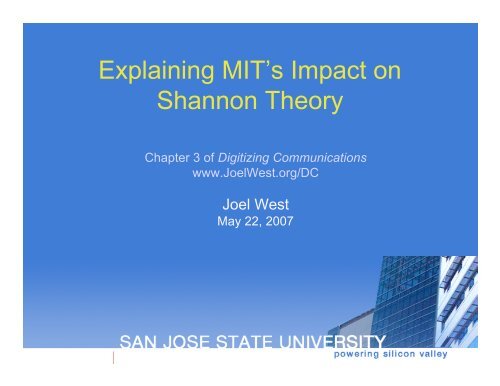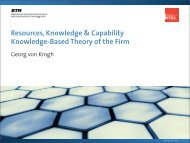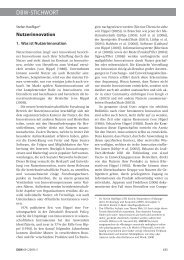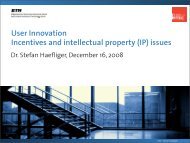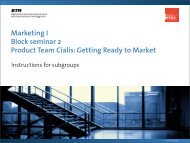Digitizing Communications - SMI
Digitizing Communications - SMI
Digitizing Communications - SMI
You also want an ePaper? Increase the reach of your titles
YUMPU automatically turns print PDFs into web optimized ePapers that Google loves.
Explaining MIT’s Impact on<br />
Shannon Theory<br />
Chapter 3 of <strong>Digitizing</strong> <strong>Communications</strong><br />
www.JoelWest.org/DC<br />
Joel West<br />
May 22, 2007
Outline<br />
• Research program & motivation<br />
• Shannon theory<br />
� Application to space communications<br />
• MIT’s Golden Age of Information Theory<br />
� Possible explanations: institutions, people<br />
• Unresolved questions<br />
• Discussion
How We Got Here<br />
Joel West (PhD, UC Irvine, 2000)<br />
• 1987-2002: PC software entrepreneur<br />
• 1994-2000: research on PC standards<br />
• 1996-1998 planned diss. on 1G cellphone launch in<br />
Japan (’79), Sweden (’81), US (’83)<br />
• 2000-2002: Qualcomm case (ECCH.org)<br />
Caroline Simard (PhD, Stanford, 2004)<br />
• Bachelor’s, master’s in communications<br />
• Stanford study w/François Bar, Woody Powell<br />
• 2001-2004: diss on 240+ San Diego wireless startups<br />
2002: met at San Diego telecom industry event
Where We Began<br />
Primary Access<br />
AirFiber<br />
1960s<br />
Radyne Comst<br />
CommQuest<br />
Copper Mtn.<br />
Ellipsis<br />
WaveWare<br />
1990s<br />
PCSI<br />
Ensemble<br />
Linkabit<br />
1980s<br />
Silicon Wave<br />
Qualcomm<br />
Leap Wireless<br />
Magis Networks<br />
Tiernan<br />
NextWave<br />
Dot Wireless
Which Leads Us To<br />
Andrew (& Erna)<br />
Viterbi<br />
Irwin (& Joan)<br />
Jacobs<br />
viterbi.usc.edu jacobsschool.ucsd.edu
Jacobs & Viterbi Story<br />
Irwin Jacobs and Andrew Viterbi:<br />
• Attend MIT (Viterbi S.B.,S.M.; Jacobs S.M., Sc.D.)<br />
• Get jobs as college professors<br />
� Jacobs: MIT 1959-1966, UCSD 1966-1971<br />
� Viterbi: UCLA 1963-1973<br />
• Start Linkabit in 1968 in Los Angels<br />
� one-day a week consulting company<br />
� move it to San Diego in 1971, Jacobs starts full-time<br />
� both quit their university jobs<br />
� sell Linkabit in 1980, continue to work until 1985<br />
• Exploding seedpod of entrepreneurship, 1985-2000
Qualcomm<br />
• Founded 1985 by Jacobs, Viterbi, 5 others<br />
� 1st prod.: Omnitracs satellite-based truck tracking<br />
• IPO in 1991<br />
• Known for inventing CDMA mobile phone IPR<br />
� Launch in 1995, adopted US, Korea, Japan, H.K.<br />
� Essential IPR for W-CDMA<br />
• Today: $75 billion market cap<br />
� Patent licensing and mobile phone chips<br />
� 2006: $7.5 billion revenues, 33% net income<br />
� Joined Fortune 500 in 1999, today #317
Research Program<br />
• Academic book (5/12 chaps in early drafts)<br />
� Target completion date: summer 2008<br />
• Transformation of US wireless communication<br />
industry from analog to digital from 1960-2000<br />
� Key technology: Shannon (1948) theory<br />
� Empirical focus: startups that create the San Diego<br />
telecom industry (and their antecedents)<br />
� Theoretical focus: technology commercialization<br />
and engineering entrepreneurship<br />
• 3-4 academic papers
Plan for the Book<br />
Working title: <strong>Digitizing</strong> <strong>Communications</strong> From MIT to Qualcomm<br />
1. Claude<br />
Shannon<br />
2. MIT<br />
3. Andy & Irwin<br />
4. Coding in<br />
Space<br />
Ch. 5-12:<br />
Linkabit,<br />
San Diego<br />
telecom<br />
industry
Application of Shannon Theory<br />
to NASA <strong>Communications</strong>
Discontinuity: Shannon Theory<br />
• Claude Shannon goes to MIT then Bell Labs<br />
• In 1948, he publishes “A mathematical theory<br />
of communication” in the Bell Tel. Lab.<br />
Journal<br />
� This launches what is called “Shannon Theory” or<br />
“information theory”<br />
• During the 1950s-1960s, an important area of<br />
research is on channel coding<br />
� Shannon’s coding theorem is ideally suited for<br />
deep space communications
Milestones in Channel Coding Theory<br />
• 1950s: Block codes<br />
� Reed-Solomon (1960) is the best<br />
• 1960s: Convolutional codes (1960s)<br />
� Sequential decoding (Wozencraft, 1957; Fano, 1963)<br />
� Viterbi decoding (Viterbi 1967)<br />
• 1970s: Concatenating block and<br />
convolutional codes (Viterbi et al 1971)<br />
• 1990s: “turbo” codes
Coding in Space<br />
• NASA needs to send data from outer planets<br />
� A billion miles away — 1/d 2 attenuation<br />
� Long missions, without solar power available;<br />
limited transmitter power (8-25 watts)<br />
• Reached limits on antenna size<br />
� 70m ground satellite dish cost $200m each<br />
� Spacecraft dish limited by booster diameter<br />
• Channel coding provides the answer<br />
� MIT alumni boost SNR by 9 dB from 1968-1989<br />
� Forney & Massey provide first 6 dB<br />
� Viterbi & Linkabit provide last 3 dB
Coding<br />
in NASA<br />
Probes<br />
Research done at MIT<br />
“MIT codes”
MIT’s Golden Age<br />
of Information Theory
Today’s Claim<br />
• MIT’s “Golden Age” of information<br />
theory extended from ca. 1950-1965<br />
� Accumulation of talent<br />
� Contributions made at MIT<br />
• The peak was 1959-1962<br />
• A concentration never seen at any other<br />
institution, before or since
MIT’s Impact During Golden Age<br />
• Largest info theory breakthroughs<br />
� As measured by IEEE Shannon prize<br />
• Steady stream of graduates<br />
� To both faculty and industry jobs<br />
• The most important textbooks<br />
� Codify tacit knowledge<br />
� Disseminate that knowledge<br />
� Define the direction of the field
MIT’s Shannon Award Winners<br />
Date<br />
1973<br />
1976<br />
1977<br />
1981<br />
1982<br />
1983<br />
1986<br />
1988<br />
1991<br />
1993<br />
1995<br />
1997<br />
2000<br />
2005<br />
Name<br />
Claude E. Shannon<br />
Robert M. Fano<br />
Peter Elias<br />
W. Wesley Peterson<br />
Irving S. Reed<br />
Robert G. Gallager<br />
William L Root<br />
James L. Massey<br />
Andrew J. Viterbi<br />
Elwyn R. Berlekamp<br />
G. David Forney<br />
Jacob Ziv<br />
Thomas Kailath<br />
Richard Blahut<br />
MIT Ties<br />
SM, PhD, faculty<br />
PhD, faculty<br />
SB, faculty<br />
Visiting associate professor<br />
Lincoln Lab<br />
SM, ScD, faculty<br />
SM, PhD, Lincoln Lab<br />
SM, PhD<br />
SB, SM<br />
SB, SM, PhD<br />
SM, ScD<br />
ScD<br />
SM, ScD<br />
SB
Course<br />
6.311<br />
6.571<br />
6.572<br />
6.573<br />
Courses (1965)<br />
Title†<br />
Principles of<br />
Communication<br />
Statistical Theory of<br />
Communication<br />
Statistical Theory of<br />
Nonlinear Systems<br />
Statistical Theory of<br />
Noise and Modulation<br />
Begun<br />
Fall 1952<br />
< 1951<br />
Fall 1961<br />
Fall 1951<br />
Instructor<br />
Elias,<br />
Wozencraft,<br />
others<br />
Lee<br />
Lee<br />
Wiesner.<br />
Siebert,<br />
Davenport<br />
Textbook<br />
Wozencraft &<br />
Jacobs (1965)<br />
Lee (1960)<br />
Wiener (1958)<br />
Davenport &<br />
Root (1958)
Course<br />
6.574<br />
6.575<br />
6.576<br />
6.577<br />
Courses (1965)<br />
Title†<br />
Transmission of<br />
Information<br />
Advanced Topics in<br />
Information Theory<br />
Statistical Theory of<br />
Detection, Estimation<br />
and Modulation<br />
Modulation Theory<br />
and Systems<br />
Begun<br />
Spring<br />
1951<br />
1956<br />
Fall<br />
1961<br />
Before<br />
1951<br />
Instructor<br />
Fano,<br />
Gallager<br />
various<br />
Siebert, Van<br />
Trees, others<br />
Baghdady,<br />
Wozencraft<br />
Textbook<br />
Fano (1961);<br />
Gallager (1968)<br />
Peterson (1961)<br />
Van Trees (1968;<br />
1971a, 1971b,<br />
2001)<br />
n/a
Why at MIT?<br />
Possible explanations:<br />
• Institutions<br />
� RadLab/RLE<br />
� MIT dominance in EE<br />
� Positive feedback of success:<br />
�Attract good PhD students<br />
�Hire own PhD students<br />
• People<br />
� Shannon<br />
� Fano & Elias<br />
� Wiener/Lee?
Institutions
Institutional Context<br />
• Applied research @ MIT<br />
� William Barton Rogers’ original goals<br />
� Rise of research in MIT engineering<br />
• Rad Lab: can we overstate its impact?<br />
• Research Laboratory of Electronics
Applied Research<br />
• Rogers wants applied research with<br />
scientific principles:<br />
� “When thus instructed in applied science, the<br />
… engineer clearly comprehends the agencies<br />
of the materials and instruments with which he<br />
works, and is, therefore, saved from the<br />
disasters of blind experiment”
Course VI “Research”<br />
• How much research in Course VI before<br />
1940?<br />
� 10/113 MIT doctorates 1865-1925<br />
� 56/928 through 1945<br />
� Many faculty in 1950 have SB or SM
Radiation Laboratory<br />
• Founded 1940 at but not in MIT<br />
• Brings MIT lots of resources<br />
� Staff of 4,000 effectively doubles MIT<br />
� MIT gets $117m from 1941-1945<br />
�Equivalent to $1.4 billion today<br />
�Army/Navy spend $2 billion (WW II) on equipment<br />
� MIT learns to use external research funding<br />
• Brings lots of talent<br />
� 8 future Nobel Prize scientists<br />
� Future MIT faculty: Wiesner, Fano
RLE<br />
Research Laboratory of Electronics:<br />
• Conduit for DoD money<br />
• Mainly used for public, pure research<br />
• Seem to have almost no strings<br />
• An institution or a confederation?
People
People<br />
• Shannon<br />
• Early Faculty<br />
• Info Theory Grad Students
Shannon @ MIT<br />
• Taught < 10 classes in 22 years<br />
� 6.575 seems to have a huge impact on people<br />
• Only 2 doctorates and 5 S.M. theses<br />
• Shy, withdraws as health fades<br />
• Best guess as to his role:<br />
� Limited personal impact<br />
� But perhaps a draw for prospective students
Academic Genealogy
Early Leaders<br />
• Fano (1947-1962?)<br />
• Elias (1953- )<br />
• Role of Wiener, Lee, Bose, Wiesner?
Info Theory Grad Students<br />
• Those who stay:<br />
� Wozencraft<br />
� Gallager<br />
� Davenport, Jacobs, Van Trees, ?<br />
• Those who leave<br />
� Huffman, Massey, Berlekamp, Forney<br />
� Why do they leave?
Ending of the Era<br />
Three possible reasons dominance ends<br />
• Knowledge gets diffused<br />
� MIT PhDs play major role<br />
• Key researchers fall away<br />
� Leave MIT<br />
� Switch to computers: Elias, Fano<br />
• Perception: “Information theory is dead”
Unresolved Questions
Shannon vs. Wiener (Lee)<br />
• Parallel wartime work<br />
� Wiener (1942) gets first publication<br />
• Shannon is father of information theory<br />
� Shannon (1948) finishes linkages<br />
� Shannon (1949) is basis of coding<br />
• Wiener, Lee, Bose mainstay of MIT<br />
� Is this effect negligible?
MIT Algebraic Coding<br />
• MIT invents, “owns” convolutional codes<br />
• Contributes also to block codes:<br />
� Huffman coding<br />
� Reed (Muller) and Reed-Solomon<br />
� Forney’s concatenated codes<br />
� Berlekamp’s Algebraic Coding Theory<br />
• More competition here<br />
• Most breakthroughs in 1950s
Who Else “Counts”?<br />
• Many info theory researchers at MIT<br />
� Phone books are boring to read<br />
• Use honors from the field?<br />
� Shannon Award<br />
� Other ITSoc awards?<br />
� IEEE medals prizes?<br />
� Other awards???<br />
• Other measures?<br />
� Textbooks, ?
Impact on Industry<br />
• PhDs into industry<br />
� Forney, Jacobs, Van Trees, Hoversten<br />
• Teaching undergrad/master’s students<br />
• Training teachers for elsewhere<br />
� Stanford<br />
� Berkeley<br />
� Notre Dame<br />
� Brown, Carleton, ?<br />
• How would you measure it?
Discussion
Explaining MIT’s Dominance<br />
• One-time paradigm shift?<br />
• Institutions and government funding?<br />
• General student & faculty quality?<br />
� Reinforced by agglomeration effects?<br />
• Was there a more graceful way to end?
Changing Nature of Comm. Eng.<br />
Shift to science-based engineering:<br />
• Before WW II, communications is a craft<br />
• In WW II, RadLab mixes EE & physics<br />
� Some evidence physics was essential<br />
• Shannon Theory is all math<br />
� New probabilistic view<br />
� In 1950s, most engineers don’t get it<br />
� MIT engineers do
Institutional Factors<br />
• 1940-1960: shift of US university<br />
research to government funding<br />
• World War II & Rad Lab are seminal<br />
� Changes scale of MIT research<br />
� Changes research culture, attitudes<br />
� MIT administrations lead US change<br />
• Postwar: unusual pure research $$
General Quality<br />
• MIT is clear leader in engineering & EE<br />
� Leader in all engineering rankings<br />
� Leader in EE from 1882-present<br />
• Attracts “best and the brightest”<br />
• No strong competition<br />
� Harvard, Caltech abdicate role until 1990s<br />
� Stanford: more entrepreneurial, less science<br />
� State universities lack resources<br />
� Success of the polytechnic model
Graceful De-institutionalization?<br />
• MIT pulls back from coding theory<br />
� “Coding is dead”<br />
� Huge opportunity in computing & C.S.<br />
• Leaves a huge void that’s never filled<br />
� Bell Labs plays limited role until it dies<br />
� UCSD establishes Information Theory and<br />
Applications Center in 2006 w/Qualcomm $<br />
• Is there a way to explicitly hand off role?


